The Micklem bridle has seen large success since its introduction, appearing on horses more and more frequently. Designed to fit the shape of the horse’s skull, the Micklem bridle is intended to be the most comfortable bridle for the horse, making it very effective. We were thrilled to be able to talk with William Micklem recently about the development of his bridle, what makes it unique, and what’s to come.
Dover:
We love the idea of creating a bridle that feels more comfortable for the horse. What spurred the idea of creating your Micklem bridle?
William Micklem:
It all started with my late father, Dick Micklem. He was an expert on horse’s teeth, therefore from an early age I was aware that the upper jaw molar teeth are much wider 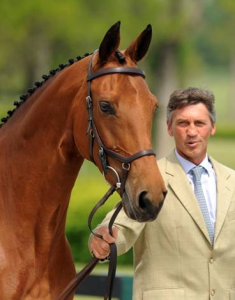 than the lower jaw molar teeth. But all we see from the outside is the smooth line of the skin going over the teeth. As a result of this many horses can become uncomfortable due to tight cavesson or flash nosebands, which put pressure on the sensitive tissue on the inside of the mouth, between the protruding outside edge of the upper-jaw molar teeth on the inside and the noseband on the outside. As a result of this, a huge number of horses can become uncomfortable or even in pain. I wanted to design a bridle and noseband that overcame this, and other problems. For example, I knew about the sensitivity on the poll but I didn’t know about the nerve points on the side of the face. All these challenges have been overcome by the Micklem bridle, which is truly designed from the inside out, from the anatomy and physiology of the skull. My Father would be smiling and having a celebratory drink!
than the lower jaw molar teeth. But all we see from the outside is the smooth line of the skin going over the teeth. As a result of this many horses can become uncomfortable due to tight cavesson or flash nosebands, which put pressure on the sensitive tissue on the inside of the mouth, between the protruding outside edge of the upper-jaw molar teeth on the inside and the noseband on the outside. As a result of this, a huge number of horses can become uncomfortable or even in pain. I wanted to design a bridle and noseband that overcame this, and other problems. For example, I knew about the sensitivity on the poll but I didn’t know about the nerve points on the side of the face. All these challenges have been overcome by the Micklem bridle, which is truly designed from the inside out, from the anatomy and physiology of the skull. My Father would be smiling and having a celebratory drink!
Dover:
How long did it take you to perfect the design of the Micklem bridle? Where there any roadblocks or particularly difficult hurdles along the way?
William Micklem:
The first basic design was, in fact, very close to what is now used. However, I also tried a huge number of variations to confirm the most effective solution. My office and house were littered with variations. I also wanted to use it as a lunge cavesson, because I  knew the Spanish Riding School used a dropped noseband type of cavesson but it was always a struggle to fit comfortably over a bridle. In fact, I was well aware that there was no comfortable lunge cavesson on the market. Later on I also wanted to use it bitless! So my ambition to be flexible was the biggest design delay. As I always say, the primary use of the Micklem is as a bridle. This remains the case, but without doubt the Micklem Multibridle is also the best lunge cavesson you will find and good lungeing is a hugely important training tool. The key point is that it is a lunge cavesson and bridle as one unit with no need to try and fit a bridle underneath. The bitless options are also useful, for example, when a mouth is sore. This is what I wanted, but for many it was both too good to be true and too much to take in. This was a roadblock in terms of bringing it to the market.
knew the Spanish Riding School used a dropped noseband type of cavesson but it was always a struggle to fit comfortably over a bridle. In fact, I was well aware that there was no comfortable lunge cavesson on the market. Later on I also wanted to use it bitless! So my ambition to be flexible was the biggest design delay. As I always say, the primary use of the Micklem is as a bridle. This remains the case, but without doubt the Micklem Multibridle is also the best lunge cavesson you will find and good lungeing is a hugely important training tool. The key point is that it is a lunge cavesson and bridle as one unit with no need to try and fit a bridle underneath. The bitless options are also useful, for example, when a mouth is sore. This is what I wanted, but for many it was both too good to be true and too much to take in. This was a roadblock in terms of bringing it to the market.
Therefore, despite having a wonderful product that produced obvious huge benefits I failed to interest equestrian wholesalers and retailers….for approximately fifteen years! My own horses, however, continued to benefit from the bridle, including my two Olympic homebreds Mandiba (Karen O’Connor) and High Kingdom (Zara Phillips). All their early work and first riding was done in a Micklem bridle. I also used the bridle throughout the photography for my book, the Complete Horse Riding Manual (Dorling Kindersley 2003), even though the bridle was not yet on the market.
Finally in 2007 Tom MacGuinness of Horseware Ireland saw the potential and was brave enough to give it a chance. The reward was immediate with awards, plaudits and solid sales. The decision to market a Micklem Competition bridle, to be used only as a bridle, was also a crucial part of its commercial progress. Without Tom and Horseware I might have just remained a frustrated inventor, albeit with some happy and comfortable horses at home. But I always believed 100% that it would take off at some point because provably it was a better product and a better design, and as I always say, “a good idea has to give way to a better idea”.
Dover:
What are a few of the key features that make the Micklem bridle unique, and what are they aiming to accomplish that a traditional bridle cannot do as effectively?
William Micklem: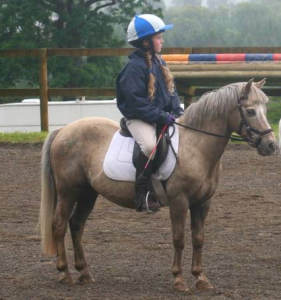
The shape is obviously unique and it takes some adults a little time to get used to it. What is interesting is that we now have a large group of children who have been brought up with the Micklem bridle. To them the Micklem bridle is the norm and traditional bridles are ‘strange’!
The Micklem bridle has a padded widened head piece with no narrow noseband strap going underneath to create poll pressure. It also avoids any pressure on the protruding upper-jaw molar teeth and the exit point of the motor and sensory nerves on the side of the face. In addition, the fitting of the front nose piece is high enough to avoid pressure on the delicate nose bones on the lower part of the face. With other types of nosebands, that fit much lower than my bridle, these bones are sometimes fractured, particularly with young horses.
When schooling it is also possible to add clips to attach the bit directly to the front nose piece. This reduces pressure on the tongue and avoids the tongue being strapped against the narrow bars of the mouth. Excessive pressure on the tongue is a major cause of discomfort and resistance especially with young horses. These simple clips can turn a nappy horse into a happy horse in minutes and they certainly protect the mouth, for example when a horse is being ridden by a novice rider.
Dover:
Can you share a particular success story where you swapped a traditional bridle to the Micklem bridle and saw a difference in the horse?
William Micklem:
There are many examples: Joseph Murphy, our Irish Olympic rider, was riding a horse called Chuckleberry at Boekelo, the CCI 3* horse trials in Holland. The horse was not comfortable in the mouth on cross country. So the next day Joseph tried a Micklem bridle and then used it immediately in the show jumping. The horse took to it immediately and jumped a beautiful, clear round.
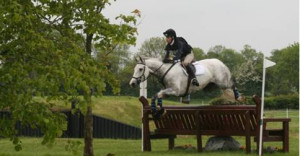 Even more dramatic was a young, stubborn horse which I was shown and asked to improve when I came to Equitana USA in Kentucky. I watched this horse generally refuse to go forwards. So I l first lunged him in a Micklem bridle and then put the rider back up. He behaved himself perfectly. So we then put the original bridle back on and the old, bad behaviour immediately returned, to an extent that surprised me. We then changed back to a Micklem, and once again he went forwards without resistance!
Even more dramatic was a young, stubborn horse which I was shown and asked to improve when I came to Equitana USA in Kentucky. I watched this horse generally refuse to go forwards. So I l first lunged him in a Micklem bridle and then put the rider back up. He behaved himself perfectly. So we then put the original bridle back on and the old, bad behaviour immediately returned, to an extent that surprised me. We then changed back to a Micklem, and once again he went forwards without resistance!
Not every horse is going to make such an obvious change, but the bottom line is that if a horse is more comfortable, they will be happier and likely to perform better. The daily difference may only be small, but accumulated incremental change makes a big difference in the medium and long term. This is why those such as German Event chef d’equipe and trainer Chris Bartle use it, and why it is becoming the bridle of choice in novice dressage. To see such legends as Andrew Nicholson, Niklas Lindback and Harry Meade use it in international eventing brings me out in goose bumps! Not to mention top jumping riders such as Meredith Michaels-Beerbaum, Rodrigo Pessoa and Andrew Bourns, and eventers Kim Severson and Marsha Kulak. When USA training and competition gurus such as Marsha Kulak use the Micklem on all their horses I know it works, and I know my Father would be in permanent party mood …. not because of my success but because he loved horses and wanted them to be more comfortable.
Dover:
What is the key to fitting a Micklem bridle on a particular horse?
William Micklem:
Fit it high enough. The front nose piece should be about four fingers above the bit, or even a little higher. In addition, the vertical cheek pieces have to fit behind the protruding cheek bones; then everything fits as it should. The fact that the cheek pieces fit behind the cheek bones (zygomatic ridge) is what gives the Micklem Multibridle stability when used for lungeing. The two back straps should also be snug and not loose, as though you were holding someone’s hand.
Dover:
Are there any variations of your bridle in the works? Such as different leather or design styles? Or any adjustments to the physics of how it fits the horse?
William Micklem:
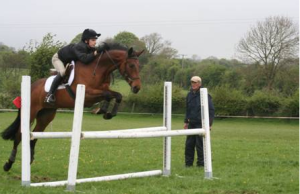 Yes, always progress! In particular, we are producing a very smart-stitched jumper and eventer bridle and a ‘bling’ dressage bridle, which will both be available through Dover. In addition, we are making the Multibridle slightly heavier to suit young horses better and give a bigger bearing surface for when it is used bitless. We will also be making strap extensions available so that horses with unusually large cheek bones can be properly fitted.
Yes, always progress! In particular, we are producing a very smart-stitched jumper and eventer bridle and a ‘bling’ dressage bridle, which will both be available through Dover. In addition, we are making the Multibridle slightly heavier to suit young horses better and give a bigger bearing surface for when it is used bitless. We will also be making strap extensions available so that horses with unusually large cheek bones can be properly fitted.
Of course I have a restless mind and many other ideas for more comfortable and better products. Horseware Ireland will be bringing these new Micklem products to the market in the near future. Wearing my hat as a trainer and coach I am excited because it is truly a win win situation with my job being made easier and horses being made happier. As I often say, the Micklem bridle is loved by trainers and loved by horses…and it’s true!
Let us know your experiences with the Micklem bridle in the comments!

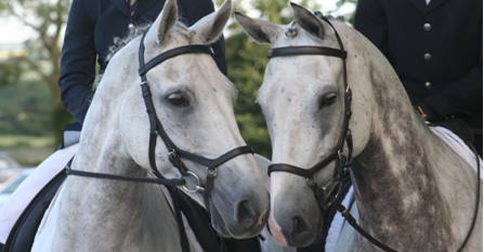
I purchased the Micklem Multibridle for my young 12HH Welsh Pony. It gives me the option to lunge and long rein for training purposes, then I can place my young child on the pony and use the bridle while bitless. Enabling her to learn to balance, steer, and control the horse without me worrying about protecting his sensitive mouth from her jarring hands. I love the way the bridle fits and its versatility. My only concern is that she learn the correct parts of the bridle. Is there a chart available with the parts labeled correctly that we can reference?
Sounds great! I am very intrigued, I would like to see the bling dressage bridle when it comes out!
I am always willing to try anything that makes for a more comfortable ride for my horse. :)
what if you dont use a flash on a horse and they don’t need it what would you suggest? as the bridle has a built in flash essentially?
We asked William what his thoughts were on this:
“For the vast majority of horses, doing up the bottom strap is not something that they object to. They find it comfortable and therefore there is no disadvantage. In addition, for the majority of time it has little effect and they do not need it, but for the times when a horse wants to open their mouth and evade the rein contact it is an invaluable help. The bottom back strap with a Micklem bridle is different from the lower strap of a flash noseband. Both fit below the bit, but with a Micklem, when a horse opens their mouth it actually raise the bit up more, like a gag action, as the line from the lowest point of the back strap to the main side ring straightens up. This strap also allows a small opening of the mouth because of this, which most horses prefer, but it also encourages them to close it again, which riders prefer!”
Give it a try Sam and see how your horse likes it!
Are you able to use a bit like the 2 ring happy mouth on this bridle?
i am wondeirng if there has been a design improvement recently. i bought the micklem mulit purely to compete bitless in a tidy leather bridle. i am very disappointed with the weak soft leather that the reins attach to. was dubious as soon as it arrived and sure enough 1 has stretched and started to tear off after a very short time. could these please be replaced with a metal ring that is securely attached to heavy duty leather. was a very expensive bridle to have last such a short time for its intended purpose.